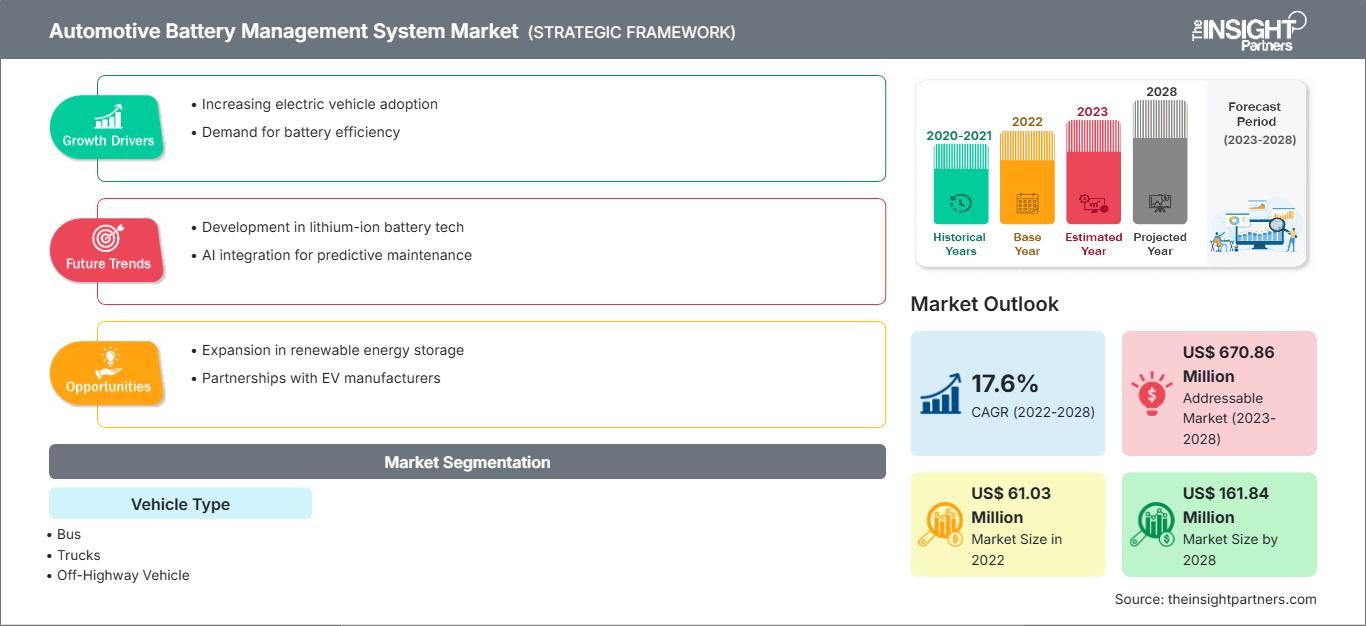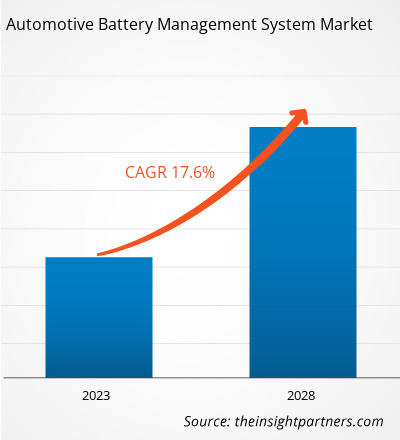Se prevé que el mercado de sistemas de gestión de baterías para automóviles crezca desde los 61,03 millones de dólares estadounidenses en 2022; se estima que crecerá a una tasa de crecimiento anual compuesta (TCAC) del 17,6% desde 2022 hasta 2028.
Un sistema de gestión de baterías (BMS) administra las baterías utilizadas en vehículos híbridos y eléctricos de alto voltaje. Los fabricantes de vehículos eléctricos y de baterías integran un BMS en las baterías de iones de litio para protegerlas. El sistema de baterías de un vehículo eléctrico se compone de múltiples elementos, como módulos de baterías, sensores, controladores, sistemas de gestión térmica y sistemas de gestión de baterías. Debido a la creciente preocupación por la protección del medio ambiente y a las iniciativas gubernamentales para reducir las emisiones, se prevé que la demanda de vehículos eléctricos e híbridos crezca a un ritmo impresionante durante el período de pronóstico de 2022 a 2028. Esto, a su vez, impulsará el crecimiento del mercado de sistemas de gestión de baterías para automóviles.
La industria global de vehículos eléctricos y baterías se caracteriza por la presencia de unas pocas empresas muy reconocidas y financieramente sólidas, como Mitsubishi, Nissan y Tesla. Por ello, el poder de negociación de los compradores en el mercado de sistemas de gestión de baterías para automóviles es bastante elevado. Gracias a la continua investigación y desarrollo en vehículos eléctricos, junto con el rápido crecimiento del mercado de sistemas de gestión de baterías, se estima que este poder de negociación se mantendrá alto entre 2019 y 2027. Las principales empresas del mercado de sistemas de gestión de baterías para automóviles emplean diferentes estrategias al planificar los sistemas de baterías para sus vehículos. Se prevé que los continuos avances tecnológicos presionen a los proveedores de sistemas de gestión de baterías para que se adapten a los cambios y mantengan su posición en el mercado. Debido a esto, los compradores también tienden a cambiar de proveedor de sistemas de gestión de baterías (BMS) con el tiempo, en función de sus necesidades específicas y del portafolio tecnológico de cada proveedor.
Obtendrá personalización gratuita de cualquier informe, incluyendo partes de este informe, análisis a nivel de país y paquetes de datos de Excel. Además, podrá aprovechar excelentes ofertas y descuentos para empresas emergentes y universidades.
Mercado de sistemas de gestión de baterías para automóviles: Perspectivas estratégicas

-
Obtenga las principales tendencias clave del mercado que se describen en este informe.Esta muestra GRATUITA incluirá análisis de datos, que abarcarán desde tendencias de mercado hasta estimaciones y pronósticos.
Impacto de la pandemia de COVID-19 en la cuota de mercado de los sistemas de gestión de baterías para automóviles
El brote de COVID-19 impactó drásticamente la economía global durante su punto álgido en 2020, obstaculizando las actividades comerciales en las industrias manufactureras. Antes del brote, la cuota de mercado de los sistemas de gestión de baterías para automóviles experimentaba un crecimiento sustancial debido al aumento de las ventas de vehículos eléctricos, el incremento de la renta disponible y la fácil disponibilidad de crédito y financiación. Además, las importantes iniciativas de inversión en el desarrollo de vehículos eléctricos impulsaban la demanda de sistemas de gestión de baterías para automóviles. Según el Consejo Internacional de Transporte Limpio, las ventas mundiales de vehículos eléctricos alcanzaron un récord de 6,9 millones en 2021, un aumento del 107 % con respecto a 2020. Sin embargo, el inicio de la pandemia de COVID-19 ralentizó la inversión y la producción de vehículos eléctricos. Durante los primeros días de la pandemia, la crisis restringió significativamente todos los acuerdos comerciales, colaboraciones y alianzas, lo que afectó al mercado de los sistemas de gestión de baterías para automóviles. La aparición de la pandemia perjudicó las ventas de vehículos en febrero de 2020; además, las ventas cayeron un 47 % en EE. UU. y un 80 % en Europa en abril. Según un informe de Statista, las ventas mundiales de automóviles cayeron a 63,8 millones en 2020 y registraron una lenta recuperación en 2021 con 66 millones de ventas.
Análisis de mercado: Mercado de sistemas de gestión de baterías para automóviles
Aumento de las ventas de vehículos eléctricos y expansión de la infraestructura para vehículos eléctricos
Las ventas de vehículos eléctricos (VE) crecen a un ritmo acelerado debido a la creciente preocupación por la protección del medio ambiente y las políticas gubernamentales que favorecen la adopción de vehículos de bajas y cero emisiones. Las subvenciones y los incentivos fiscales ofrecidos por los gobiernos animan a los fabricantes a ampliar sus procesos de producción. Según el informe Global Electric Vehicle Outlook, las ventas de coches eléctricos, incluidos los vehículos totalmente eléctricos e híbridos enchufables, alcanzaron los 6,6 millones de unidades en 2021. Ese mismo año, las ventas en China se dispararon hasta los 3,3 millones, lo que representa aproximadamente la mitad de las ventas mundiales. Además, las ventas de VE crecieron un 65 % en Europa, hasta alcanzar los 2,3 millones de unidades, mientras que en Estados Unidos se duplicaron hasta las 630 000 unidades en 2021. Por lo tanto, el aumento de las inversiones en infraestructura de recarga y el incremento de las políticas gubernamentales favorables están impulsando la producción de baterías, lo que a su vez refuerza la demanda del mercado de sistemas de gestión de baterías para automóviles.
Información basada en el tipo de vehículo
Según el tipo de vehículo, el mercado de sistemas de gestión de baterías para automóviles se segmenta en autobuses, camiones y vehículos todoterreno. En 2022, el segmento de autobuses representó la mayor cuota de mercado debido a la creciente adopción de baterías en estos vehículos para mitigar las emisiones de carbono. Además, se prevé que el segmento de camiones registre la mayor tasa de crecimiento anual compuesto (TCAC) durante el período de pronóstico. La demanda de sistemas de gestión de baterías está aumentando significativamente por parte de los fabricantes de autobuses eléctricos debido a las crecientes iniciativas para optimizar el rendimiento de las baterías y monitorizar la temperatura de los paquetes de baterías. Asimismo, la necesidad de autobuses escolares eléctricos está creciendo en diferentes países para reducir la contaminación por carbono, lo que también permite a los fabricantes de autobuses escolares eléctricos ampliar sus líneas de producción. Varios gobiernos de diferentes países están adoptando autobuses con tecnología ecológica, lo que impulsa la demanda de autobuses eléctricos de larga distancia y, por consiguiente, el crecimiento del mercado de sistemas de gestión de baterías para automóviles.
Perspectivas regionales del mercado de sistemas de gestión de baterías para automóviles
Los analistas de The Insight Partners han explicado en detalle las tendencias regionales y los factores que influyen en el mercado de sistemas de gestión de baterías para automóviles durante el período de previsión. Esta sección también analiza los segmentos y la geografía del mercado de sistemas de gestión de baterías para automóviles en Norteamérica, Europa, Asia Pacífico, Oriente Medio y África, y Sudamérica y Centroamérica.
Alcance del informe de mercado de sistemas de gestión de baterías para automóviles
| Atributo del informe | Detalles |
|---|---|
| Tamaño del mercado en 2022 | 61,03 millones de dólares estadounidenses |
| Tamaño del mercado para 2028 | 161,84 millones de dólares estadounidenses |
| Tasa de crecimiento anual compuesto global (2022 - 2028) | 17,6% |
| Datos históricos | 2020-2021 |
| período de previsión | 2023-2028 |
| Segmentos cubiertos |
Por tipo de vehículo
|
| Regiones y países cubiertos |
América del norte
|
| Líderes del mercado y perfiles de empresas clave |
|
Densidad de los participantes del mercado de sistemas de gestión de baterías para automóviles: comprensión de su impacto en la dinámica empresarial
El mercado de sistemas de gestión de baterías para automóviles está creciendo rápidamente, impulsado por la creciente demanda de los usuarios finales debido a factores como la evolución de las preferencias de los consumidores, los avances tecnológicos y una mayor conciencia de los beneficios del producto. A medida que aumenta la demanda, las empresas amplían su oferta, innovan para satisfacer las necesidades de los consumidores y aprovechan las nuevas tendencias, lo que impulsa aún más el crecimiento del mercado.

- Obtenga una visión general de los principales actores del mercado de sistemas de gestión de baterías para automóviles.
Los actores que operan en el mercado de sistemas de gestión de baterías para automóviles se centran principalmente en el desarrollo de productos avanzados y eficientes.
- En agosto de 2021, Varta, empresa experta en baterías, y Continental Engineering Services (CES), proveedor de servicios de desarrollo y producción, anunciaron una colaboración. Como parte de un primer proyecto piloto, ambas compañías desarrollaron conjuntamente un paquete de baterías reemplazable de 48 voltios para vehículos eléctricos de dos ruedas con una potencia de 10 kW o superior.
- En junio de 2021, Carrar, una empresa israelí que crea sistemas superiores de gestión térmica para el sector de la movilidad eléctrica, anunció que Gentherm, líder del mercado y creador de soluciones de gestión térmica de vanguardia, es el principal inversor en una ronda de financiación semilla.
El mercado de sistemas de gestión de baterías para automóviles se divide en cinco regiones principales: Norteamérica, Europa, Asia Pacífico (APAC) y el resto del mundo. En 2022, Asia Pacífico lideró el mercado con una importante cuota de ingresos, seguida de Europa. Además, se prevé que Asia Pacífico registre la mayor tasa de crecimiento anual compuesto (TCAC) del mercado entre 2022 y 2028.
Continental AG, Dana Limited, GENTHERM, Hanon Systems, Mahle GmbH, NXP Semiconductors, Renesas Electronics Corporation, Robert Bosch GmbH, Valeo y Marelli Holdings Co., Ltd. se encuentran entre los principales actores del mercado de sistemas de gestión de baterías para automóviles. El informe de mercado ofrece información detallada que ayuda a estos actores a planificar su crecimiento para los próximos años.
- Análisis histórico (2 años), año base, pronóstico (7 años) con CAGR
- Análisis PEST y FODA
- Tamaño del mercado, valor/volumen: global, regional y nacional
- Industria y panorama competitivo
- Conjunto de datos de Excel
Informes recientes
Informes relacionados
Testimonios
Razón para comprar
- Toma de decisiones informada
- Comprensión de la dinámica del mercado
- Análisis competitivo
- Información sobre clientes
- Pronósticos del mercado
- Mitigación de riesgos
- Planificación estratégica
- Justificación de la inversión
- Identificación de mercados emergentes
- Mejora de las estrategias de marketing
- Impulso de la eficiencia operativa
- Alineación con las tendencias regulatorias






















 Obtenga una muestra gratuita para - Mercado de sistemas de gestión de baterías para automóviles
Obtenga una muestra gratuita para - Mercado de sistemas de gestión de baterías para automóviles